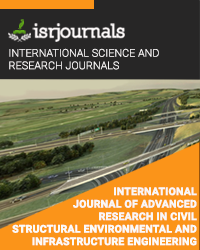a study on infrastructural development using gis in resource management
T.Rajaprawin,S.Loganathan
Published in International Journal of Advanced Research in Civil,Structural,Environmental and Infrastructure Engineering and Developing
ISSN: 2320-723X Impact Factor:1.7 Volume:1 Issue:2 Year: 08 March,2014 Pages:52-59

Abstract
The purpose of this study is to improve the utilization of resources in construction industry. Resource planning is a critical task for management. Resource planning is a critical task for management. It identifies the various resources are needed for building throughout its life period. Effective resource management increases profitability of optimum utilization of resources in and around construction industry. This system provides a technical support for the full & effective management and use for the transportation of resources. This can be done with the use of emerging field, Geographical Information System (GIS). GIS is a tool, which has an ability to handle both spatial and attributes. This platform provides a sophisticated facility compared to available tool, which helps to interlink various resources to be allocated effectively. This facility provides the manager, to a new experience in construction industry.
Kewords
map, GIS, resources.
Reference
1] H., P.B. Shah, M.Schmidt, and G. Kennedy, 1989. “Himalayan-scale problems and micro-GIS solutions”, In A Wider Perspective, GIS ’89 Symposium Proceedings, Vancouver, Canada, March 7-10, 1989. Vancouver, BC: Forestry Canada, 179-184. 2] Sheffield, R.M. and L.A. Royer, 1989. “GIS: A broad-scale inventory perspective”, In Proceedings, Society of American Foresters National Convention, Spokane, Washington, September 24-27, 1989. 38-42. 3] M.L. and D.E. McKinsey, 1991. “Using a Geographic Information System for Prescribed Fire Management at Cuyamaca Rancho State Park, California”, In GIS Applications in Natural Resources, M. Heit and A. Shortreid, ed. Fort Collins, Colorado: GIS World. 4] Woodwell, G.M. and T.A. Stone, 1990. “The global forest inventory: 5] Measurements using satellite imagery and geographic information systems in Amazonian forestry”, In Making It Work, GIS ’90 Symposium Proceedings, Vancouver, Canada, March 13-16, 1990. Vancouver, BC: Forestry Canada, 345. 6] C. Prakasam1 and Biplab Biswas, 2012. “Evaluation of Geomorphic Resources Using Gis Technology: A case study of selected villages in ausgram block, burdwan district, West bengal, India”. Department of Geography The University of Burdwan Golapbag, Burdwan – 713104 West Bengal, India 7] Miller, R. C., D. P. Guertin and P. Heilman (2004) Information Technology in Watershed Management Decision Making. Journal of the American Water Resources Association, 40(2): 347-358. 8] Obermeyer, N. (1995) The Hidden GIS Technocracy. Cartography and Geographic Information Systems, 22(1): 78-83. 9] Parkes, M. and R. Panelli (2001) Integrating Catchment, Ecosystems and Community Health: The Value of Participatory Action Research. Ecosystem Health, 7(2): 85-106. 10] Rambaldi, G., P. A. K. Kyem, P. Mbile, M. McCall and D. Weiner (2005) Participatory Spatial Information Management and Communication in Developing Countries. Mapping for Social Change International Conference, Nairobi, Kenya. 11] Robinson, A. and B. Petchenik (1976) The Nature of Maps: Essays Towards Understanding Maps and Mapping. Chicago: University of Chicago Press. 12] Sahay, S. (1998) Implementing GIS Technology in India: Some Issues of Time and Space. Accounting, Management, and Information Technologies, 8: 147-188. 13] Sheppard, E. (1995) GIS and Society: Towards a Research Agenda. Cartography and Geographic Information Systems, 22(1): 5-16. 14] Sheppard, E. (2005) Knowledge Production through Critical GIS: Genealogy and Prospects. Cartographica, 40(4): 5-21. 15] Schuurman, N. (2006) Formalization Matters: Critical GIS and Ontology Research. Annals of the Association of American Geographers, 96(4): 726-739. 16] Sieber, R. E. (2003) Public Participation Geographic Information Systems across Borders. Canadian Geographer-Geographe Canadien, 47(1): 50-61.

